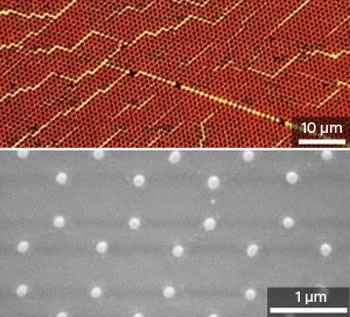| Posted: Sep 24, 2014 |
Quantum spectroscopy of plasmonic nanostructures
|
|
(Nanowerk News) As the sensitivity of plasmonic sensors reaches new heights, so does the challenge of using tiny sample volumes. Dmitry Kalashnikov and co-workers at the A*STAR Data Storage Institute in Singapore have devised an innovative way to improve sensor accuracy by exploiting the unique properties of quantum optics ("Quantum Spectroscopy of Plasmonic Nanostructures").
|
 |
| Dark-field microscopy (top) and scanning electron microscopy (bottom) images showing an array of plasmonic nanoparticles used as a highly sensitive sensor.
|
|
Some new sensors based on plasmonic nanostructures can detect responses from samples that contain only about 100,000 molecules. While increased sensitivity is a boon, the low volumes of the sample mean that the light used to probe such tiny amounts can induce unwanted changes in them. Therefore, it is necessary to probe samples using very low light levels — even down to the ultimate limit of single photons. However, conventional techniques cannot cope with such small amounts of light: the signal strength from a sample becomes low compared with the background noise, rendering accurate detection impossible.
|
|
To address this problem, Kalashnikov and his team created a pair of ‘frequency-entangled’ photons by passing laser light through a nonlinear crystal. The frequencies of these two photons add up to that of the photon that initially hit the crystal. Thus, by measuring the frequency of one photon, the researchers could easily calculate the frequency of the other one.
|
|
To set up the measurement system, the researchers sent one of the photons to a plasmonic sensor — a hexagonal array of gold nanoparticles — and detected it with a highly sensitive light detector (see image), while using a spectrometer to measure the frequency of the other photon. By measuring the number of photon pairs that are simultaneously spotted by the two light detectors, they could determine the dependence of the transmittance of the sensor on the frequency.
|
|
To investigate the robustness of the measurements to background noise, the researchers then artificially introduced noise to the measurement of the photon that passed through the spectrometer. With this, they found that their technique could detect a tiny change in the refractive index (approximately 1 per cent) of a liquid sample placed immediately in front of the plasmonic sensor — even in the presence of severe noise up to 70 times stronger than the signal. When they performed the same measurement using conventional spectroscopy, they found that the noise completely swamped the signal.
|
|
“The trick is that both photons reach the detectors at the same moment, whereas noise is completely random, making it highly unlikely to cause both detectors to fire simultaneously,” Dmitry explains.
|
|
The extremely low photon levels of the technique make it suitable for measuring photosensitive compounds and ultralow concentrations of other substances.
|

